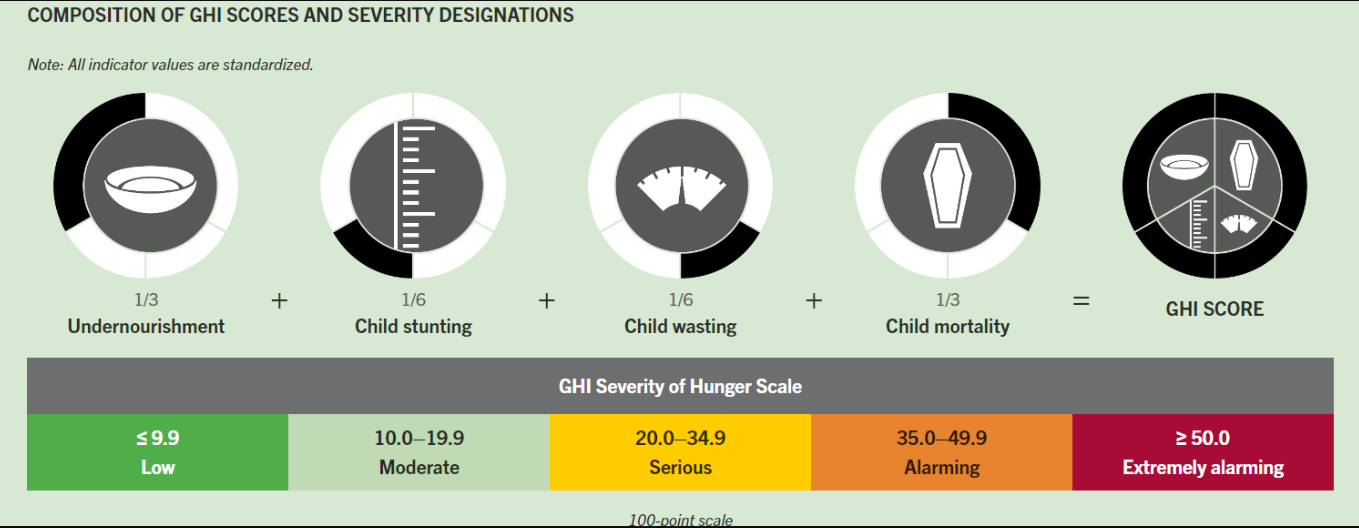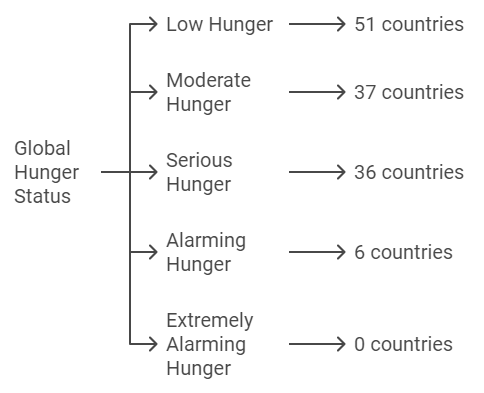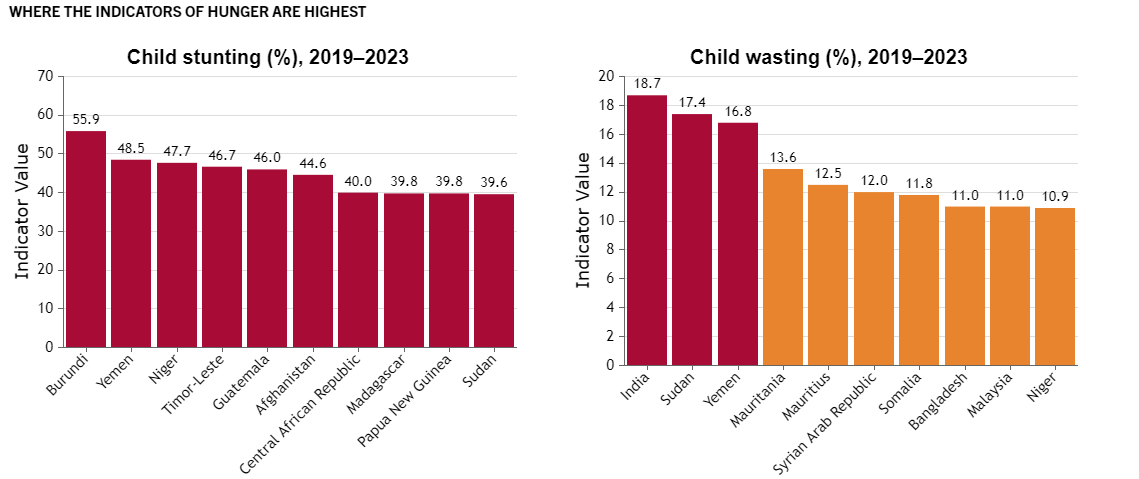Social Justice
Global Hunger Index 2024
- 22 Oct 2024
- 13 min read
For Prelims: Food and Agriculture Organization of the United Nations (FAO), Child Wasting, Undernourished, Child Mortality, Income Inequality, Rapid Urbanization, Climate Change, National Food Security Act, Poshan Abhiyan (National Nutrition Mission), PM Garib Kalyan Yojana (PMGKAY), National Mission for Natural Farming, Ministry of Women and Child Development, Poshan Tracker, UNICEF, WHO, World Bank, NFSA, Targeted Public Distribution System (TPDS), Saksham Anganwadi and Poshan 2.0, Food Safety and Standards Authority of India (FSSAI), Integrated Child Development Services (ICDS).
For Mains: Issues Related to Food Security and Hunger in India, Government Initiatives Related to Food Security and Elimination of Hunger.
Context
Recently, the Global Hunger Index 2024 has been released by Concern Worldwide and Welthungerhilfe.
- It highlights that India faces a ‘serious’ level of hunger, ranking it 105th out of 127 countries.
What is the Global Hunger Index?
- Defining Hunger: The Food and Agriculture Organization of the United Nations (FAO) defines hunger as a state of food deprivation, or undernourishment, where an individual consistently consumes too few calories to meet the minimum dietary energy requirements.
- This requirement is influenced by factors such as gender, age, stature, and physical activity level, all of which determine the energy a person needs to maintain a healthy and productive life.
- The Global Hunger Index (GHI): It is published annually by Concern Worldwide and Welthungerhilfe, serves as a tool to measure and monitor hunger at global, regional, and national levels.
- Its primary objective is to raise awareness about the ongoing fight against hunger and to highlight regions of the world where hunger is most severe, urging for increased efforts in these areas.
- Indicators of Hunger: The GHI is calculated using a comprehensive formula that captures the multidimensional aspects of hunger. This formula is based on four key indicators:
- Undernourishment: Represents the portion of the population with insufficient caloric intake.
- Child Stunting: The percentage of children under the age of five who have low height for their age, indicating chronic undernutrition.
- Child Wasting: The percentage of children under five who have low weight for their height, a sign of acute undernutrition.
- Child Mortality: The percentage of children who die before reaching the age of five, partially reflecting the impact of poor nutrition and unhealthy living conditions.
What are Global Hunger Trends Highlighted in the Report?
- Global GHI Score (2024):
- The world’s 2024 Global Hunger Index (GHI) score is 18.3, classified as moderate hunger. This represents only a slight decrease from the 2016 score of 18.8, indicating slow progress .
- Child Malnutrition:
- Stunting: 148 million children under five are stunted (low height for age), reflecting chronic malnutrition .
- Wasting: 45 million children under five suffer from wasting (low weight for height), indicating acute malnutrition .
- Child Mortality: Almost 5 million children die before reaching the age of five due to hunger-related causes .
- Undernourishment: 733 million people globally are undernourished. Additionally, 2.8 billion people are unable to afford a healthy diet due to food price hikes and the ongoing cost-of-living crisis .
- Food Insecurity and Crises:
- Acute Food Insecurity: In 2023, 281.6 million people across 59 countries faced acute food insecurity. Projections for 2024 suggest 120–130 million people will need humanitarian food assistance by the end of the year .
- Most Affected Regions:
- Africa, South of the Sahara and South Asia exhibit the highest levels of hunger.
- Six countries, including Somalia, Yemen, Chad, Madagascar, Burundi, and South Sudan, face alarming levels of hunger .
- Somalia faces a prolonged hunger crisis due to conflict, economic challenges, and climate shocks, with 51.3% of the population lacking sufficient calories- the second-highest globally.
- Projections for Global Hunger:
- At the current pace, global hunger will not be eradicated by 2030. If progress continues at the observed rate, low hunger globally may not be achieved until 2160, which is over 130 years from now .
- Hunger Levels in Countries:
- Hunger is classified as alarming in six countries-Burundi, Chad, Madagascar, Somalia, South Sudan, and Yemen. Additionally, 36 countries are experiencing serious hunger levels .
- Stagnation in Key Areas:
- Progress in reducing the four GHI indicators- undernourishment, child stunting, child wasting, and child mortality- is falling short of internationally agreed targets .
- Countries in Decline:
- Hunger has increased since 2016 in 22 countries with moderate, serious, or alarming GHI scores. Progress has largely stalled in 20 countries, with scores declining by less than 5% .
- Success Stories:
- Some countries, including Bangladesh, Mozambique, Nepal, Somalia, and Togo, have made notable improvements in their GHI scores, though hunger levels remain high in these regions .
- Compounding Challenges: The 2024 GHI results highlight a series of overlapping challenges that exacerbate hunger, particularly in the world’s poorest countries:
- Armed Conflicts: Conflicts continue to displace populations and disrupt food production and distribution, with recent wars in Gaza and Sudan exacerbating food crises.
- Climate Change: Accelerating climate change is severely impacting agriculture, reducing yields and increasing food insecurity .
- Climate change is causing widespread disruption across much of Sub-Saharan Africa. Since 1961, it has reduced agricultural productivity growth in the region by 34%.
- High Food Prices and Market Disruptions: Rising food prices and market disruptions are preventing many from accessing nutritious food .
- Economic Downturns and Debt Crises: Economic downturns and high levels of debt in low-income countries are limiting their ability to invest in food security .
- Displacement and Inequality:
- Over 115 million people are internally displaced or forced to migrate due to conflict, persecution, and climate-related disasters .
- Rising Inequality: Although extreme poverty has decreased in middle-income countries, income inequality remains high, particularly in the poorest nations affected by conflict or instability. Poverty levels in these regions are now worse than before the pandemic .
What are India Specific Findings of the Report?
- GHI Score and Severity:
- India’s GHI score for 2024 remains in the serious category, with a score of 27.3. Despite some improvements, hunger levels remain high .
- Child Malnutrition:
- Child Wasting: India has one of the highest child wasting rates globally, indicating acute malnutrition. As per the report the rate of child wasting stands at 18.7% among children under five.
- Child Stunting: India also faces a significant challenge with stunting highlighting widespread chronic malnutrition. According to the report about 35.5% of children are classified as stunted.
- Undernourishment: As per the report approximately 13.7% of the population is undernourished, highlighting a serious food access issue .
- Child Mortality: According to the report, the child mortality rate indicates that 2.9% of children die before reaching their fifth birthday, reflecting inadequate nutrition and unhealthy living conditions that contribute to high death rates for children under five .
- Food Security Challenges:
- India’s serious hunger problem stems from various challenges, including poor diet quality, income inequality, rapid urbanization, climate change, and inadequate access to nutritious foods .
- The poor nutritional status of mothers significantly contributes to child malnutrition, pointing to an intergenerational cycle of undernutrition .
- Regional Comparisons:
- South Asia, where India is a major contributor, has the highest child wasting rates globally .
- With 281 million undernourished people, South Asia accounts for nearly 40% of the global total.
- Government Initiatives: India has shown "significant political will" to transform the food and nutrition landscape through initiatives such as:
What are Objections of India Over Data Collection Methodology?
- Concerns Raised by the Ministry: In 2023, the Ministry of Women and Child Development raised issues regarding the data not being sourced from their ICT application, the ‘Poshan Tracker.’
- The Ministry highlighted that organizations like UNICEF, WHO, and the World Bank recognize this tracker as a significant tool, noting that child wasting rates appeared consistently lower at 7.2% compared to the 18.7% reported in the 2023 index.
- Researchers' Position: Researchers counter that they rely on survey estimates validated for the Joint Malnutrition Estimates and the WHO Global Database on Child Growth and Malnutrition.
- They argue that utilizing the same data sources ensures consistency and comparability in the results.
- They warn that making exceptions for any specific country could undermine the validity of rankings.
What are Some of the Recommendations of the Report?
- Comprehensive Approach: The GHI report 2024 advocates for a multifaceted strategy that includes enhanced access to social safety nets, addressing various factors affecting well-being and nutrition, and focused efforts to assess and meet nutritional needs.
- Strengthen Accountability to International Law: Governments must uphold the right to adequate food, formalize this right in laws, and ensure transparent monitoring systems.
- This involves linking early hunger warning systems to prompt action and funding relief efforts .
- Promote Gender-Transformative Approaches: Food systems and climate policies should consider gendered needs and vulnerabilities.
- Women's leadership should be encouraged in managing resources, and inclusive governance structures must be established to support these goals .
- Invest in Gender, Climate, and Food Justice: Public resources should address structural inequalities, and investments should be made in nutrition, rural development, and gender-transformative climate adaptation.
- These efforts should also focus on long-term resilience, including debt relief for low-income countries and sustainable development
UPSC Civil Services Examination, Previous Year Questions (PYQs)
Prelims:
Q. Which of the following is/are the indicator/indicators used by IFPRI to compute the Global Hunger Index Report? (2016)
1. Undernourishment
2. Child stunting
3. Child mortality
Select the correct answer using the code given below:
(a) 1 only
(b) 2 and 3 only
(c) 1, 2 and 3
(d) 1 and 3 only
Ans: (c)
Mains:
Q. How far do you agree with the view that the focus on lack of availability of food as the main cause of hunger takes the attention away from ineffective human development policies in India? (2018)









